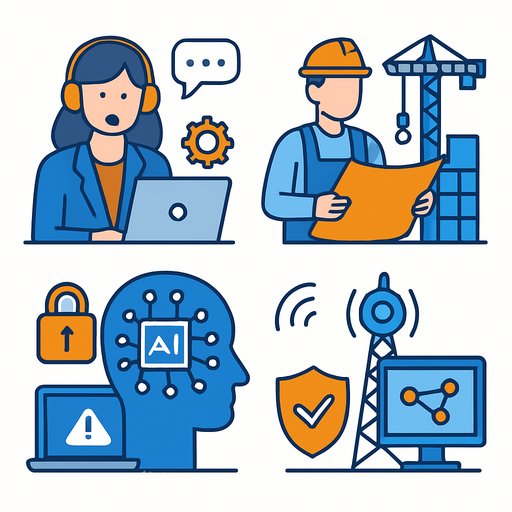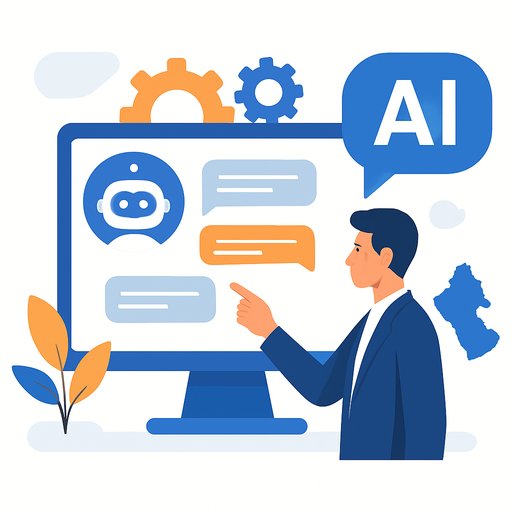AI in Broadband: What Customer Support Leaders Need to Know
AI isn't just hype anymore. It's threading into customer support, network ops, construction planning, and security across broadband - and it's changing how support teams work day-to-day.
Here's what the latest reports say, where adoption is real, and the exact plays support leaders can run right now without breaking the customer experience.
Where Broadband Executives Are Using Agentic AI
A Google Cloud report found that by mid-June 2025, more than half of broadband execs had adopted agentic AI in some form. Self-reported usage (companies with $10M+ revenue):
- Security operations and cybersecurity: 47%
- Tech support: 46%
- Customer service and experience: 45%
- Product innovation and design: 45%
- Marketing: 43%
- Productivity and research: 43%
- Software development: 41%
- Network/equipment configuration and automation: 39%
Important nuance: adoption isn't execution. Another report (IFS) found 52% of execs say they lack budget or system readiness - even though 88% report improved profitability and 74% see higher-than-expected ROI. Translation: pick the right use cases, prove value fast, then scale.
Customer Service: Practical Plays You Can Run This Quarter
Big players like AT&T and T-Mobile have leaned in. Early movers such as Windstream by Kinetic started using AI for support in 2024, and tools like RouteThis are pushing higher self-install success. Done well, agentic AI resolves issues before customers ever reach your queue.
But don't lose the human. A Cisco study showed 89% believe the best experience blends human empathy with AI efficiency. You need both.
High-Impact Use Cases
- Proactive incident prevention and comms: Use telemetry and agentic workflows to detect degradation, open tickets, message impacted customers, and offer fixes - before they call. Track AHT, FCR, and deflection from outbound comms.
- Self-install and Tier-0 automation: AI-guided setup with camera-based checks, Wi-Fi placement hints, and instant signal tests. Clear guardrails and one-tap human handoff stop frustration.
- Adaptive troubleshooting: Dynamic decision trees that react to device signals, account flags, and prior fixes. Push next best step to the agent or to the customer in chat.
- Knowledge that writes itself: Mine tickets and call transcripts for recurring fixes. Auto-draft articles, then require human approval. Retire stale steps every sprint.
- QA at scale: Auto-score 100% of interactions for tone, policy, root cause, and resolution accuracy. Feed coaching moments straight to team leads.
- Smart routing: Classify intent, language, sentiment, and risk in real time. Route high churn-risk customers to senior agents; send simple resets to Tier-0.
Guardrails You'll Actually Use
- Data hygiene: Redact PII, tokenize IDs, and separate prod from training data. No customer secrets in prompts.
- Human-in-the-loop: Agent review for credits, cancellations, or anything that affects billing or service level.
- Clear boundaries: Define what the bot can and can't do. Always provide a visible "talk to a person" option.
- Observability: Log prompts, responses, and outcomes. Tag failures (wrong fix, long loops, angry tone) for fast iteration.
- Fallbacks: If confidence is low or signals conflict, escalate to a human with full context attached.
KPIs That Prove It's Working
- Containment rate (self-serve and bot)
- FCR and AHT by intent
- CSAT and NPS on AI-only vs. human-assisted paths
- Truck roll avoidance and self-install success
- Cost per assist and time to resolution
Construction and Field Support: What Changes for CX
With BEAD rolling out and the Fiber Broadband Association projecting a 2.3x jump in fiber miles (159M to 373M), planning and field ops will strain without smarter tooling. AI can help you keep customers informed and reduce repeat visits.
- Planning: Prioritize build zones with demand, cost, and permit signals. Forecast install dates more accurately for sales and care teams.
- Quality control: Auto-flag out-of-spec photos and measurements before a tech leaves the site.
- Speech-to-text for techs: Hands-free notes that instantly create structured tickets and update the knowledge base.
- Pattern spotting: Detect repeat failures by device model, firmware, or geography; push preemptive fixes to customers.
Cybersecurity: Prepare Support for the New Normal
AI adoption has coincided with a wave of attacks. Verizon reports an 85% increase in mobile attacks, with 63% of respondents saying outages lasted at least a day. Comcast tracked 25 billion attacks in the last year, and Semperis found 71% of companies had at least one high-impact event that halted critical functions.
The upside: AI helps you respond fast. AT&T is testing an AI receptionist to reduce spam calls, and the IEA highlights real-time detection, automated response, and stronger phishing detection as effective defenses.
- Support playbook: Prewrite surge comms, status page updates, and agent scripts for security incidents.
- Authentication defaults: Enforce step-up verification during suspected attacks; add warnings for spoofed numbers and domains.
- Phishing triage assistant: Classify customer-reported messages, auto-generate safe replies, and escalate threats to SecOps.
- After-action: Auto-summarize incidents, customer impact, and refunds; push learnings into macros and training.
What's Next: AI at the Edge
Some providers are experimenting with embedding AI in routers and edge devices. For support, that could mean instant local diagnostics, smarter QoE tuning, and privacy-friendly on-device analysis.
It's early, but expect pilots to expand through 2026. Plan for new playbooks, new metrics, and tighter collaboration with network teams.
14-Day Quick Start for Support Leaders
- Days 1-3: Map your top five intents by volume and cost. Pull 100 transcripts each and tag failure points.
- Days 4-7: Launch a narrow bot (one intent). Add strict guardrails and an obvious human handoff.
- Days 8-10: Auto-draft knowledge updates from transcripts. Ship agent-only first; then publish to customers.
- Days 11-14: Pilot with 10% of traffic. Measure containment, CSAT deltas, and AHT. Review mistakes; iterate weekly.
If you need a structured path to upskill your team on practical AI for support, explore focused programs here: AI courses by job role.
Bottom Line
Start small, prove value, keep a human in the loop, and measure everything. The teams that ship useful AI - not just talk about it - are already seeing faster resolution, fewer truck rolls, and happier customers.
Your membership also unlocks:





